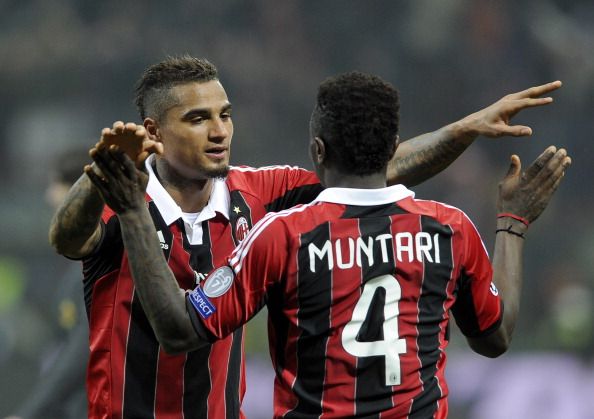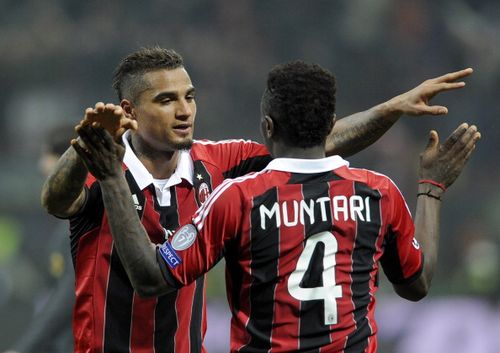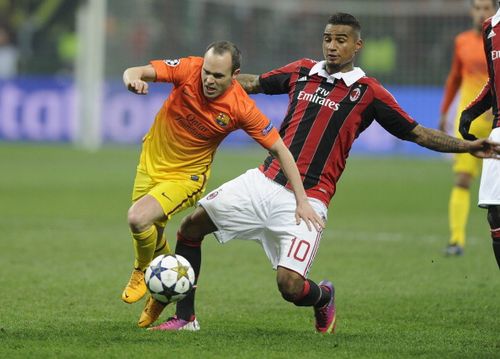
A few things we can learn from Barcelona's and Arsenal's first leg failures

Recent fixtures in the knockout round of the UEFA Champions League have raised some serious questions.
After successfully managing Porto and accepting a record deal with Barcelona, it’s evident to state that 1996-97 was Bobby Robson’s most successful year in management, as he managed a treble with Barcelona. ‘Bobby five-O’ was asked as to what he thought was essential in football. His actual quote wasn’t recorded, but he said that the key to his success lied in a simple concept.
“Befriend the football, keep it with you like you own it, look at your opposition as pesky Income Tax officials and keep the ball away from them.”
It was during this time, that the elegant possession play surfaced and took center stage.
Having had the chance to go through a lot of youth systems during my free time, great clubs like Barcelona, Ajax, Arsenal, SC Braga and Southampton all taught their youth teams to keep the ball and frustrate the opposition, which would eventually lead to an opening. The footballers of the yesteryear were impatient, and would tend to do something stupid, lose their focus and concentration, which was very often the cause that instigated results in a game.
At the La Masia, they have a whole chapter that teaches them the importance of keeping possession.

This concept of possession play was heralded by the world of football, critics drew positive reviews, and tacticians began to crack their heads, trying to find a solution to this necessary evil as they tried to break the monopoly of these extremely well-organised teams.
Quite a lot of teams have tried to adapt to possession play. However, the ones that have performed better than the rest are Barcelona and Arsenal.
It doesn’t seem so long ago, when the sturdy midfields of the Premier League teams were being torn apart by a Dutch playmaker, Dennis Bergkamp, bossed around by a towering presence of a Frenchman, Patrick Vieira, and being made to work their socks off to mark another slippery Frenchman, Robert Pires. That probably sums up the greatness of the Arsenal midfield in the early 2000s. Arsene Wenger came to Arsenal with a vision, of free-flowing possession-based football, and he’s achieved that with Arsenal.
Le Professeur followed the Bobby Robson philosophy, and brought in many titles in his early years at Arsenal.
“If the football field was an orchestra, Xavi and Iniesta are the orchestrators,” said no one, but it’s a quote that’s definitely speaks for itself. No one needs an introduction about how special Xavi and Iniesta are for Barcelona and Spain alike!
In 2008, Sir Alex Ferguson stated that if you won over Barcelona’s mighty and dominant midfield, victory was all yours! But that’s a rare feat in itself. A lot of great teams across Europe have tried to dominate and dissect Barcelona’s ‘tiki-taka’ style of play, yet the maximum that one can manage is keeping the ball for a maximum of four-five passes, after which the added pressure by Barcelona players results in them winning the ball back. Tiki-taka comprises of the very basics of football in its philosophy of short passes, but what it teaches the opposition is probably the most important in football. A slight lapse in concentration and focus, a slight mistake in your positioning, and you’re caught off guard!
Barcelona lack the physical presence in midfield, but with Tiki-taka, they make the most sturdiest of midfielders look like mere dunces as the ball goes up and down the park. This style of play brought up the concept of a ‘false 9′.
But of late, Barcelona’s tiki-taka and Arsenal’s possession play have earned some criticism. Is it justified?
In Arsenal’s mid-week Champions League round of 16 game against Bayern Munich, in spite of being outplayed in attack, possession statistics reveal a different story! The possession was in Arsenal’s favor, as a massive 56% possession is what the London side amassed against a very focused and admirable opposition in Bayern Munich.

Now for those of you who didn’t watch the match, for whatever reason that could be, you wont be butchered by analysts for assuming that Arsenal would have had more shots on target and more chances. But a mere 8 shots overall, in comparison to a humongous 17 from Bayern Munich, are worrying signs.
For those of you who saw the match, you’re going to have to agree with me that no matter how many passes Arsenal amassed, every pass backwards lead to a collective groan from the fans in the stadium, to those sulking in front of their TV sets alike. I’m trying to find a right word for it, and boring fits the bill perfectly, doesn’t it?
One might start to wonder that with possession, you’re expected to have more efforts on goal, and if you don’t, then something clearly needs to change. Apart from the heroics of a certain Jack Wilshere, the Arsenal midfield were no match for the German pairing of Tony Kroos and Bastian Schweinsteiger.
Switching our focus to the Barcelona – AC Milan tie.

When AC Milan drew Barcelona in the Champions League, people were already beginning to think about the potential opponents that Barcelona might face in the quarterfinals. Under-estimating the youth power that Milan possess, yesterday night’s performance was a sucker-punch to their doubters, as the Rossineri stood victorious, claiming the scalp of the European giants.
Let’s have a look at the statistics.
What defines madness? In this scenario, having a possession of about 73% and yet managing just ONE shot on target? That’s madness. Many people believe that Milan had ‘parked the bus’. But that’s being clever for me.
If stats can’t save you, then nothing can.
Probably the example of a pressure-cooker can best define the scenario.
AC Milan soaked the pressure, and when the time came, sprung attacks at Barcelona, which paid rich dividends. They steamed forward like a determined lot and delivered when it mattered.
What can all of this possibly explain?
Everything in football has its time, and the tiki-taka, or in plain English, possession play, has passed its prime.
How can you possibly explain the fact that a club like Barcelona, that’s averaged more than 2 goals per game this season, drew blanks in Milan? The World Player of the Year, Lionel Messi didn’t even have a single sniff at goal? A possession of SEVENTY-THREE percent couldn’t get you a goal?
I’m still searching for answers, but I guess the apt answer would be a change in tactics. The modern footballer has become a more efficient, and can average over 10 kilometers per game, and so tracking back to stop an attack, or in the words of a troll, ‘parking the bus’, is very much possible. The game demands versatility, probably more long balls, and things like well-worked corners could do the trick for Barcelona. Taking your chances when they come could do the job as well, as you’re left to rue them if your missed chances ultimately turn out to be the difference between the two teams. As Ole Gunnar Solksjaer famously said after being asked about a stunning save by Paul Robinson to parry his shot wide: “There are no such things as good saves, it’s just a bad finish.”
Being clinical is the need for the hour. That’s what the game demands.
Let’s hope the second legs stand up to the occasion, as we’re being treated to some glorious football and drama by the very best in the world!